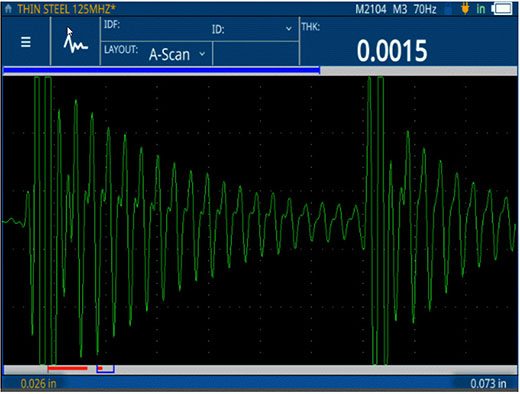![]()
Batches of coiled steel often need to be inspected for compliance with thickness specifications. Conventional measurements are limited to the cut edges at the head of the coil. Ultrasonic thickness measurements, on the other hand, are made from one side only—the exposed side—making it possible to monitor the thickness over the entire width of the coil. Since the thickness can vary as much as 0.002–0.004 in. (0.05–0.10 mm) from the edges to the center, steel processors greatly benefit from using small ultrasonic gauges.
Equipment Used to Inspect the Thickness of Metal Coils
Equipment selection for the metal coils thickness inspection depends on the accuracy that is required. Higher accuracy can be achieved by combining precision thickness gauges, such as the 38DL PLUS™ gauge or 45MG gauge with Single Element software, with a 20 MHz (M208) or 10 MHz (M202) delay line transducer. In general, the calibrated accuracy with these gauges combined with an M116 contact transducer is ±0.001 in. (±0.01 mm). In the High Resolution mode, the gauges are capable of a calibrated accuracy of ±0.0003 in. (±0.008 mm) or better if the thickness measurements are taken with the M208 or M202 delay line transducers under optimal circumstances. Continuous on-line thickness gauging can also be applied to coiled steel using immersion transducers.
For thin-walled applications with thicknesses below 0.008 in. (0.203 mm), the 72DL PLUS™ high-frequency thickness gauge is recommended. As a high-speed instrument, the 72DL PLUS gauge features a waveform update rate of 60 Hz and a measurement rate of up to 2 kHz. It offers a large, full color touch screen for great visibility from different angles and supports wireless LAN and Bluetooth® for modern connectivity and integration. The image on the right shows an example waveform using the 72DL PLUS gauge and the M2104 (125 MHz) transducer to measure a 0.0015 in. (0.0381 mm) steel sheet. |  |



